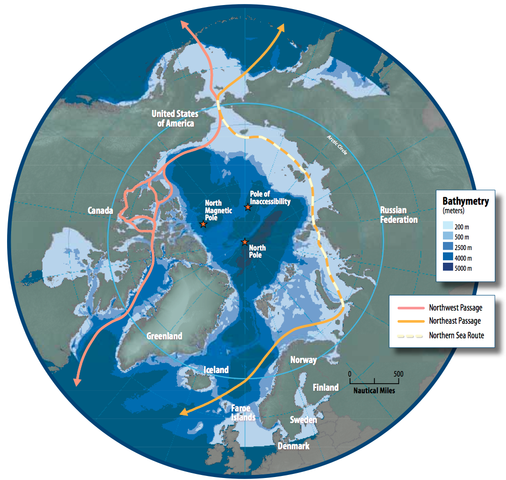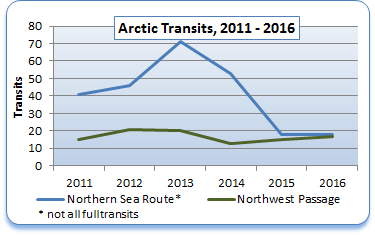The Arctic Ocean currently offers two ship transportation routes, The Northeast
Passage, which includes the Barents Sea and the Northern Sea Route (NSR), through
Russian waters, and the Northwest Passage (NWP) through US and Canadian waters.
As sea ice melts, Arctic transportation routes remain open for longer periods
during summer months, enticing shippers to use these routes instead of alternatives
such as the Suez Canal. Since both the NSR and NWP have approximately 30-40%
shorter sailing distances, the average times savings of potentially 10-13 fewer
days, mean that ships sailing through either passage would save time and fuel costs.

Shipping vs Ice Frame
Transit Traffic
Significant obstacles remain however to choosing the Arctic route alternative.
These include: 1) difficulties navigating because of unexpected remaining ice floats,
2) remoteness and inadequate search and rescue facilities, 3) the need and expense
for icebreakers or escort ships, 4) access limited only to summer months with
uncertain time boundaries, and 5) reluctance of insurers to cover risks associated
with transit uncertainties. Other considerations have constrained traffic in recent
years, such as lower fuel costs and, particularly in the case of the NSR, political
sanctions against Russia. For example, when Russian sanctions took effect in 2013,
the year transits reached their peak there, transits in the NSR plummeted from over
70/year to less than 20/year, and have yet to recover.
In comparison NWP transits
increased from 5 in 2005 to 16 in 2016 with the receding summer ice allowing
increasingly extended periods. Voyages along the NWP are predominately made in
smaller vessels able to navigate in the shallow waters and tight passages, unlike
the larger, less risky NSR. But increasingly, larger ice capable passenger ships
have been making the journey in the NWP.

Most experts predict that the rapid pace of ice melt in the Arctic will, despite
the currently obstacles lead to a significant increase in ocean traffic in the
next 10-20 years.
For more information about Arctic transits see

For available transits data:



